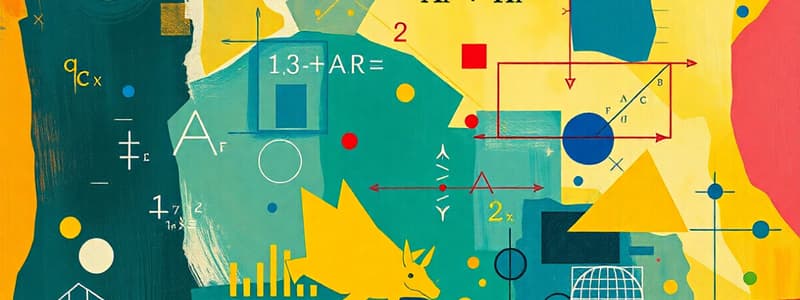Podcast
Questions and Answers
What is the result of adding the numbers 4 and 7?
What is the result of adding the numbers 4 and 7?
- 12
- 10
- 13
- 11 (correct)
Which of the following describes a variable in mathematics?
Which of the following describes a variable in mathematics?
- A symbol representing numbers (correct)
- A type of equation
- A fixed numerical value
- A symbol representing a constant
In geometry, what is the area of a rectangle with a length of 5 units and a width of 3 units?
In geometry, what is the area of a rectangle with a length of 5 units and a width of 3 units?
- 15 square units (correct)
- 10 square units
- 12 square units
- 8 square units
What does the Pythagorean theorem describe?
What does the Pythagorean theorem describe?
Which of the following represents a derivative in calculus?
Which of the following represents a derivative in calculus?
What is a characteristic of prime numbers?
What is a characteristic of prime numbers?
What is an example of inductive reasoning?
What is an example of inductive reasoning?
Which symbol represents division in mathematical notation?
Which symbol represents division in mathematical notation?
Flashcards are hidden until you start studying
Study Notes
Key Concepts in Mathematics
1. Fundamental Operations
- Addition: Combining numbers to get a sum.
- Subtraction: Finding the difference between numbers.
- Multiplication: Repeated addition of a number.
- Division: Splitting a number into equal parts.
2. Algebra
- Variables: Symbols representing numbers (e.g., x, y).
- Expressions: Combinations of numbers and variables (e.g., 3x + 5).
- Equations: Mathematical statements expressing equality (e.g., 2x = 10).
- Functions: Relationships where each input has a single output (e.g., f(x) = x^2).
3. Geometry
- Shapes: Two-dimensional (e.g., triangles, circles) and three-dimensional (e.g., cubes, spheres).
- Angles: Measured in degrees; types include acute (< 90°), right (= 90°), and obtuse (> 90°).
- Area and Perimeter:
- Area: Space within a shape (e.g., A = l × w for rectangles).
- Perimeter: Distance around a shape.
4. Trigonometry
- Ratios: Relationships between the angles and sides of triangles (sine, cosine, tangent).
- Pythagorean theorem: a² + b² = c² for right triangles.
- Unit circle: Helps to define trigonometric functions.
5. Calculus
- Limits: Understanding the behavior of functions as they approach a value.
- Derivatives: Measure of how a function changes as its input changes.
- Integrals: Calculate the area under a curve or the accumulation of quantities.
6. Statistics
- Data Collection: Methods for gathering data (surveys, experiments).
- Descriptive Statistics: Summarizing data using measures like mean, median, mode.
- Probability: The study of uncertainty; ranges from 0 (impossible) to 1 (certain).
7. Number Theory
- Prime Numbers: Natural numbers greater than 1 that have no positive divisors other than 1 and themselves.
- Divisibility: A number is divisible by another if the division results in a whole number.
- Greatest Common Divisor (GCD): Largest number that divides two or more numbers without leaving a remainder.
8. Mathematical Reasoning
- Inductive Reasoning: Drawing general conclusions from specific examples.
- Deductive Reasoning: Deriving specific conclusions from general principles or premises.
9. Mathematical Notation
- Symbols: Common symbols include + (addition), - (subtraction), × (multiplication), ÷ (division).
- Parentheses: Indicate the order of operations.
10. Applications of Mathematics
- Everyday life: Budgeting, cooking measurements, time management.
- Science and Engineering: Physics calculations, statistical analysis in research.
- Economics: Analyzing trends, financial modeling.
Study Strategies
- Practice problems regularly.
- Utilize visual aids (graphs, diagrams).
- Engage in group study for collaborative learning.
- Use online resources and apps for additional practice.
Fundamental Operations
- Addition, subtraction, multiplication, and division are the core mathematical operations that form the basis for arithmetic.
- Addition combines numbers (e.g., 3 + 2 = 5) while subtraction finds the difference (e.g., 5 - 2 = 3).
- Multiplication is repeated addition, such as 4 × 3 equating to adding 4 three times.
- Division distributes a number into equal parts, exemplified by 12 ÷ 3 = 4.
Algebra
- Variables such as x and y represent unknown numbers, essential for formulating equations.
- Expressions like 3x + 5 consist of numbers and variables combined through operations.
- Equations, such as 2x = 10, assert that two expressions are equal, important for solving for unknowns.
- Functions like f(x) = x² prescribe a unique output for each input, illustrating dependencies between variables.
Geometry
- Shapes can be classified as two-dimensional (like triangles and circles) or three-dimensional (such as cubes and spheres).
- Angles are measured in degrees; types include acute (< 90°), right (= 90°), and obtuse (> 90°).
- Area calculates the space within a shape (e.g., the area of a rectangle is length × width), while perimeter measures the boundary length.
Trigonometry
- Ratios such as sine, cosine, and tangent represent the relationships between triangle angles and sides.
- The Pythagorean theorem (a² + b² = c²) is critical for calculating the lengths of sides in right triangles.
- The unit circle is a fundamental tool in defining trigonometric functions and analyzing their properties.
Calculus
- Limits explore the function's behavior as it approaches specific values, forming the foundation for calculus.
- Derivatives quantify how a function changes with respect to changes in its input, crucial for understanding rates of change.
- Integrals are used to compute the area beneath curves, representing accumulated quantities over intervals.
Statistics
- Data collection encompasses techniques like surveys and experiments to obtain relevant information.
- Descriptive statistics summarize data through measures such as mean, median, and mode, providing insights into datasets.
- Probability ranges from 0 (impossible event) to 1 (certain event) and relates to the likelihood of occurrences.
Number Theory
- Prime numbers are natural numbers greater than 1 with no divisors other than 1 and themselves, key in number classification.
- Divisibility informs whether one number can be evenly divided by another, shaping various mathematical problems.
- The greatest common divisor (GCD) identifies the largest number that divides two or more numbers without a remainder.
Mathematical Reasoning
- Inductive reasoning derives general principles from specific instances, fostering hypothesis formation.
- Deductive reasoning deduces specific conclusions from broader generalizations or established premises.
Mathematical Notation
- Important symbols include + for addition, - for subtraction, × for multiplication, and ÷ for division, facilitating communication in mathematics.
- Parentheses dictate the order of operations, ensuring calculations are performed correctly (e.g., 2 × (3 + 4) = 14).
Applications of Mathematics
- Integrates into everyday life, influencing budgeting, cooking measurements, and time management.
- Crucial in science and engineering for calculations in physics and statistical analyses in research methodology.
- Used in economics for analyzing trends and developing financial models, impacting decision-making.
Study Strategies
- Regular practice of problems solidifies understanding and technique.
- Visual aids like graphs and diagrams enhance comprehension of complex concepts.
- Engaging in group studies promotes collaborative learning and diverse perspectives.
- Utilizing online resources and apps offers additional practice opportunities and varied learning methods.
Studying That Suits You
Use AI to generate personalized quizzes and flashcards to suit your learning preferences.




